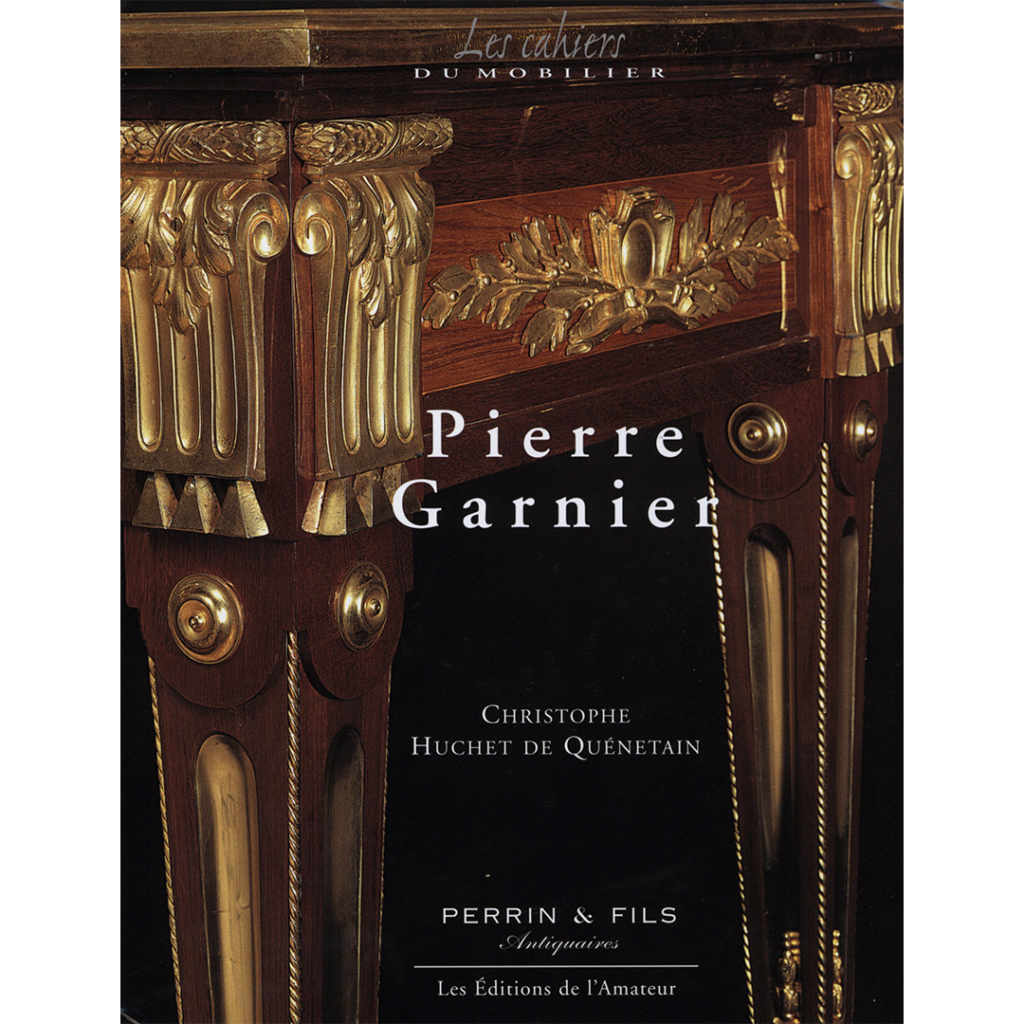
Pierre Garnier
Les Éditions de l’Amateur
Christophe Huchet de Quénetain, Dr. Colin B. Bailey (Préface),
Pierre Garnier, 1726/27-1806, Paris,
Les éditions de l’Amateur, 2003.
Commentaires
Dr. Ulrich Leben, assistant conservateur, The James A. Rothschild Collection, Waddesdon Manor, août 2003 :
« Quelle accumulation d’informations, j’espère que le public pourra apprécier cet opus. Sincèrement. »
Dr. Colin B. Bailey, conservateur en chef, The Frick Collection, New York, août 2003 :
« Pierre Garnier has long been acknowledged as a pioneer of neoclassical furniture design in France _ a leading practitioner of the « style Louis XVI militant » in Christophe Huchet de Quénetain’s felicitous phrase. As one of the foremost ébénistes of the 1760s and 1770s, Garnier’s furniture –elegant, monumental, at times unexpectedly minimalist, but always exquisitely crafted- reflects the revolution in taste inaugurated by Lalive de Jully’s cabinet flamand of the late 1750s. While there are exemplary pieces by Garnier in such prestigious and well-documented public collections as The Louvre, The Wallace Collection, The Gulbenkian and The Huntington (none at The Frick Collection, alas!), and while several major objects have recently reappeared at auction, the ébéniste himself has been less well served in the scholarly literature on the decorative arts that has flourished during the past two decades. Building upon the indispensable surveys by Eriksen and Verlet –and the more recent, sumptuously illustrated compendia by Alexandre Pradère and Thibaut Wolvesperges- Christophe Huchet de Quénetain has produced the first comprehensive monograph on Pierre Garnier’s life and work. Full of new and unpublished information –the notaries’ archive has been plundered to excellent effect- this beautifully produced book also contains a catalogue raisonne; indeed, all extant works by, or attributed to, Garnier are meticulously described in these pages.
If Pierre Garnier’s birthdate still eludes us, thanks o Christophe Huchet de Quénetain we now know that he was born between 1726/1727 –a year after Lalive de Jully- and that he died in May 1806 (and not 1800, as had previously been assumed). The elements of his precocious apprenticeship –he was made maître-ébéniste at the age of sixteen- and his rapid and successful establishment as maître et marchand ébéniste after April 1760 are laid out with exemplary concision, as is the network of Garnier’s familial and professional connections among the prosperous practitioners of the Parisian luxury trades. At one level, his story is one of determined social advancement. From solid, but modest artisanal beginnings –like François Boucher, his mother did not know how to read or write- Garnier established himself on the rue Neuve des Petits-Champs, in the heart of Paris’s financial district. Honest and hardworking, confident in his actions and opinions –a professional graphologist has analysed his handwriting!- at the end of his career (he retired at the age of seventy-three) Garnier was still renowed » par la bonté de ses constructions. » Having lost his clientele after the emigration, Garnier’s last years were predictably impoverished and at his death his estate was valued at a mere 303 francs. There is furthermore a certain poignancy in the unsuccessful efforts made by his only son, Etienne-Barthélémy –the history painter and future President of the Académie des Beaux-Arts, upon whose classical education Garnier and his wife had spared no expense- to find his ageing father a sinecure as « conservateur des meubles et autres objets d’ébénisterie » in the newly formed Museum.
Garnier’s career of the period 1760-1780 make for happier reading, and it is related with exemplary precision and sympathy by Christophe Huchet de Quénetain. One could not wish for a more enthusiastic and knowledgeable cicerone to Garnier’s oeuvre. The range of materials in wich Garnier excelled –from tulip wood and amaranth to Japanese and Chinese lacquers- as well as the variety of furniture he designed –from sumptuous secretaries en armoire to mahogany furniture inspired by contemporary English design- are abundantly illustrated in this definitive study, one that will long do service as a model of its kind. »
Revue de Presse
Jean Bedel, « La valeur des choses », France Info, 9 janvier 2004, 15h.51, 17h.51, 21h.19 et 23h.21 :
« Deux livres viennent de sortir, consacrés à deux grands ébénistes du XVIIIème siècle […]. L’autre ébéniste se nomme Pierre Garnier, il est réputé pour l’élégance et la finition de ses meubles néo-classiques. Christophe de Quénetain retrace avec précision le parcours de cet enfant du Faubourg Saint-Antoine, reçu maître en 1742. Cressent [sic, Garnier] se fait, selon l’auteur, le militant du « style à la grecque ». Avec ce premier livre dédié à un grand ébéniste riche de détails inédits, Christophe de Quénetain a réussi un coup de maître. Aux Editions de l’Amateur. »
Olivier Guez, « Hommes et Idées », La Tribune, 16-17 janvier 2004, n° 24.465, p. 29 :
« ART Pierre Garnier ébéniste. Christophe Huchet de Quénetain, historien et expert d’art, a réalisé une aussi passionnante que méticuleuse étude sur Pierre Garnier, un pionnier de l’ébénisterie néoclassique en France et l’une des figures majeures du style « Louis XVI militant » selon la formule de l’auteur. Dans cette belle monographie richement illustrée, Christophe Huchet de Quénetain décrit et analyse le mobilier de Garnier, son élégance et son exécution parfaite, réalisée pour la plupart entre 1760 et 1780. Aujourd’hui certaines pièces de Garnier sont évaluées à plusieurs millions d’euros. O.G. « Pierre Garnier », par Christophe Huchet de Quénetain. Les Editions de l’Amateur (67 euros). »
Laurence Mouillefarine, « Vu, lu, entendu », Madame Figaro, 24 janvier 2004 :
« Pour les amateurs du style Louis XVI, paraît chez le même éditeur une étude consacrée à Pierre Garnier signée
C. Huchet de Quénetain. »